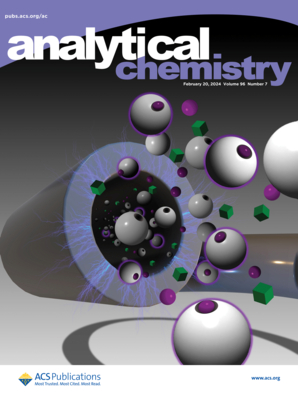Differentiated Intra-Ligand Charge Transfer Boosting Multicolor Responsive MOF Heterostructures as Robust Anti-Counterfeiting Labels
IF 6.7
1区 化学
Q1 CHEMISTRY, ANALYTICAL
引用次数: 0
Abstract
Metal–organic framework (MOF) heterostructures with hybrid architectures and abundant functional sites possess great potential applications in advanced information security, yet still suffer from the harsh stimuli mechanisms with restrained emission control. Herein, the differentiated design strategy on intra-ligand charge transfer is first reported to realize smart-responsive multicolor MOF heterostructures as robust anticounterfeiting labels. Designed similar MOF blocks with the differentiated intra-ligand charge transfer are integrated via time-dependent epitaxial growth to form multicolor MOF heterostructures. Different numbers of electron-donating groups in MOF blocks offer distinct space regulation on the torsion of charge transfer ligands, which trigger the diverse responsive emissions under the same mild stimuli, thus generating multiple tunable color patterns in heterostructures. These spatial-resolved MOF heterostructures with stable multicolor responsive modes permit the encoding of fingerprint information, which further functions as robust anti-counterfeiting labels with high-security convert states. These results offer a promising route for the function-oriented exploitation of smart-responsive MOF heterosystems for advanced information anticounterfeiting.

差异化配体内电荷转移促进多色响应 MOF 异质结构作为坚固耐用的防伪标签
具有混合结构和丰富功能位点的金属有机框架(MOF)异质结构在先进的信息安全领域具有巨大的应用潜力,但仍存在发射控制受限的苛刻刺激机制。本文首次报道了配体内电荷转移的差异化设计策略,以实现智能响应的多色 MOF 异质结构,并将其用作坚固的防伪标签。设计出的具有差异化配体内电荷转移的类似 MOF 块通过时间依赖性外延生长整合成多色 MOF 异质结构。MOF 块中不同数量的电子捐献基团可对电荷转移配体的扭转提供不同的空间调节,从而在相同的温和刺激下触发不同的响应发射,从而在异质结构中产生多种可调颜色模式。这些空间分辨 MOF 异质结构具有稳定的多色响应模式,可以编码指纹信息,并进一步用作具有高安全转换状态的坚固防伪标签。这些成果为以功能为导向利用智能响应 MOF 异质系统实现先进的信息防伪提供了一条大有可为的途径。
本文章由计算机程序翻译,如有差异,请以英文原文为准。
求助全文
约1分钟内获得全文
求助全文
来源期刊

Analytical Chemistry
化学-分析化学
CiteScore
12.10
自引率
12.20%
发文量
1949
审稿时长
1.4 months
期刊介绍:
Analytical Chemistry, a peer-reviewed research journal, focuses on disseminating new and original knowledge across all branches of analytical chemistry. Fundamental articles may explore general principles of chemical measurement science and need not directly address existing or potential analytical methodology. They can be entirely theoretical or report experimental results. Contributions may cover various phases of analytical operations, including sampling, bioanalysis, electrochemistry, mass spectrometry, microscale and nanoscale systems, environmental analysis, separations, spectroscopy, chemical reactions and selectivity, instrumentation, imaging, surface analysis, and data processing. Papers discussing known analytical methods should present a significant, original application of the method, a notable improvement, or results on an important analyte.
 求助内容:
求助内容: 应助结果提醒方式:
应助结果提醒方式:


